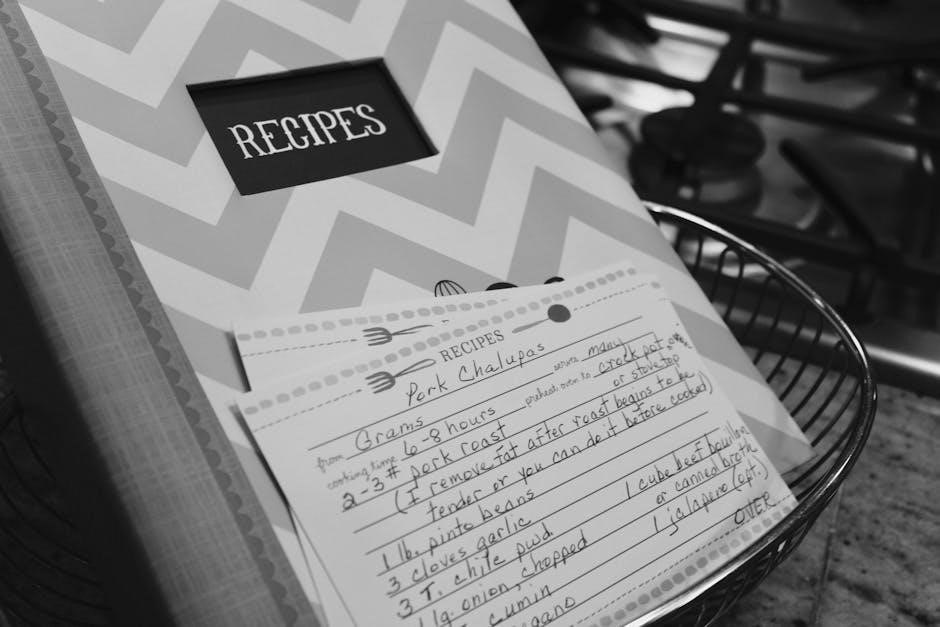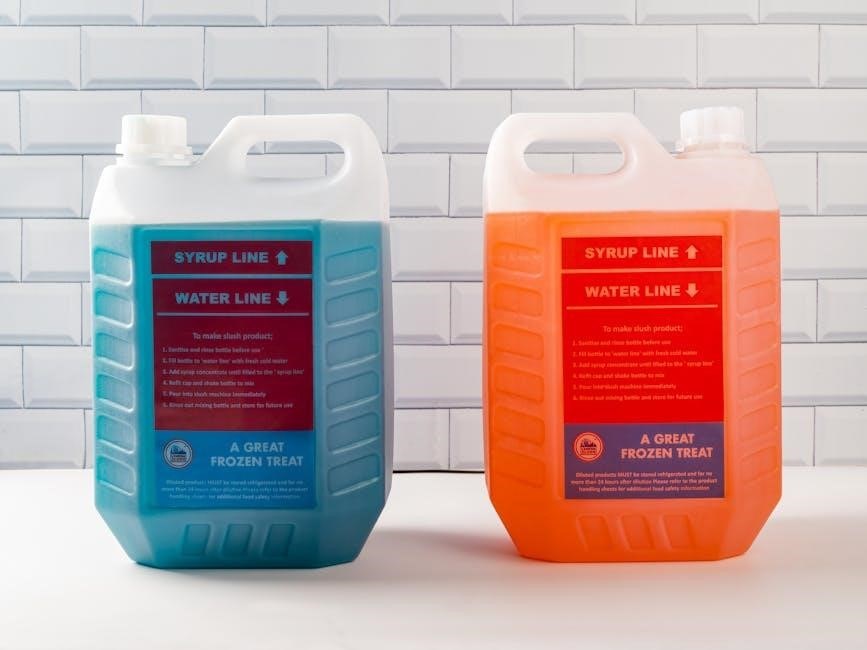Writing clear recipe instructions is essential for ensuring dishes are prepared correctly. It involves organizing ingredients, tools, and steps logically to guide cooks of all skill levels effectively.

1.1 Importance of Clear Instructions in Recipes
Clear instructions in recipes are crucial for ensuring dishes are prepared accurately and safely. Ambiguity can lead to mistakes, affecting the final result and potentially causing food safety issues. Precise step-by-step directions help cooks of all skill levels follow the process confidently. Using action verbs and numbered lists enhances clarity, making recipes easier to understand. Additionally, clear instructions minimize errors, such as incorrect ingredient measurements or cooking times, which can ruin a dish. By providing detailed, logical guidance, recipes become accessible to everyone, ensuring consistent and delicious outcomes. Clear writing also builds trust in the recipe and its author, making it more likely to be followed and shared.
1.2 Basic Structure of a Recipe

A well-structured recipe typically includes two main sections: ingredients and instructions. The ingredients list specifies the necessary components, often in chronological order, with precise measurements and quantities. The instructions provide a step-by-step guide to preparing the dish, using action verbs and numbered lists for clarity. Additional elements may include serving suggestions, cooking times, and equipment requirements. A clear structure ensures that readers can follow the recipe effortlessly, regardless of their skill level. Organizing the information logically helps prevent confusion and guarantees a successful outcome. This standard format makes recipes accessible and user-friendly, whether for home cooks or professional chefs. Consistency in structure is key to effective recipe communication.
1.3 Key Elements of Effective Recipe Writing
Effective recipe writing relies on clarity, precision, and logical organization. Clear language helps avoid confusion, while precise measurements ensure accuracy. Action verbs guide readers through steps, and consistency in terminology maintains clarity. Including essential details like cooking times and temperatures is crucial. Breaking complex processes into simple, manageable steps enhances accessibility. These elements work together to create a user-friendly guide, making recipes enjoyable and achievable for all skill levels. Attention to detail and clear communication are vital for a successful culinary experience. By focusing on these principles, recipes become both informative and engaging, ensuring delicious results every time. Effective recipe writing is about balance—providing enough detail without overwhelming the reader. This approach fosters confidence in the kitchen and encourages creativity.

Ingredients Section
The ingredients section lists all components needed, ensuring clarity and specificity. Measurements are included for accuracy, and items are organized logically to guide preparation efficiently.
2.1 Listing Ingredients in Chronological Order
Listing ingredients in chronological order enhances clarity and efficiency. This method organizes items based on when they are used in the recipe, reducing errors and streamlining preparation. By grouping ingredients according to their usage in each step, cooks can prepare components as needed, ensuring a smooth workflow. This approach is particularly helpful for complex dishes with multiple stages, as it prevents confusion and saves time. Chronological ordering also allows for better meal prep, as ingredients can be measured and prepped in the order they appear. This logical structure is essential for guiding cooks through the recipe effectively and ensuring a successful outcome.
2.2 Specifying Quantities and Measurements
Clearly specifying quantities and measurements is crucial for accurate recipe execution. Use standard units like cups, grams, or milliliters to avoid ambiguity; For example, instead of “a handful of flour,” write “1 ½ cups (190g) all-purpose flour.” Indicate whether measurements are level, packed, or sifted, as this affects results. When an ingredient is used in multiple steps, list the total amount first, followed by “divided” to clarify portioning. For instance, “2 tablespoons butter, divided.” Include conversions between imperial and metric systems if possible. Use precise language for liquids, such as “1 cup (240ml) whole milk.” Avoid vague terms like “a pinch” without defining it. This ensures clarity and consistency, helping cooks achieve the desired outcome. Always double-check measurements for accuracy to prevent recipe failures.
2.3 Grouping Ingredients by Course or Preparation
Grouping ingredients by course or preparation helps organize recipes logically. For multi-course meals, separate ingredients for appetizers, mains, and desserts. When preparing multiple components, like sauces or sides, list ingredients accordingly. This clarifies the recipe’s structure and prevents confusion; For example, in a recipe with a main dish and a marinade, group marinade ingredients first, then the main dish items. Similarly, for baked goods, group dry ingredients separately from wet ones. This method ensures cooks can prepare ingredients efficiently and follow steps seamlessly. It also helps in meal planning and grocery shopping. Clear grouping enhances readability and reduces errors, making the recipe more user-friendly. Always ensure each group is labeled clearly, such as “For the sauce” or “For the crust.” This approach is especially useful in complex recipes with multiple elements.
2.4 Indicating Substitutions and Variations
Indicating substitutions and variations in a recipe enhances its versatility and accommodates different dietary needs and preferences. When listing ingredients, suggest alternatives, such as plant-based substitutes for dairy or gluten-free options for baked goods. For example, note “(or vegan alternative)” alongside specific ingredients. Variations, like optional spices or garnishes, can be mentioned in the instructions or as separate notes. Clearly label substitutions to avoid confusion, ensuring they align with the recipe’s flavor and texture. Including these options makes the recipe more inclusive and adaptable, catering to diverse tastes and restrictions. Always explain how substitutions might affect the final result, such as texture or taste changes, to help cooks make informed decisions. This approach encourages creativity while maintaining the dish’s integrity.

Instructions Section
A well-structured instructions section guides cooks through preparation with clarity. Use numbered steps, action verbs, and include cooking times and methods for precise guidance.
3.1 Writing Step-by-Step Directions
Writing step-by-step directions is crucial for ensuring recipes are easy to follow. Begin by breaking down the cooking process into logical, sequential steps. Use clear, concise language and action verbs like “preheat,” “whisk,” or “simmer” to guide the reader. Each step should focus on a single action to avoid confusion. Include specific details such as cooking times, temperatures, and required tools. For example, “Preheat the oven to 375°F (190°C)” or “Cook for 15-20 minutes, or until golden brown.” Avoid jargon and ensure instructions are accessible to all skill levels. Using numbered lists enhances readability, while bolding key terms like measurements or equipment helps emphasize important details. Providing examples, such as “stir constantly” or “let it rest,” ensures clarity. This structured approach guarantees recipes are replicated consistently and successfully.
3.2 Using Action Verbs in Instructions
Using action verbs in recipe instructions ensures clarity and precision. Verbs like preheat, mix, sauté, and simmer guide cooks through each step. Starting each instruction with an action verb helps readers understand what to do next. For example, “Preheat the oven to 350°F” or “Stir the mixture until combined.” This approach keeps sentences concise and avoids ambiguity. Action verbs also help maintain a consistent tone and make the recipe easier to follow. They ensure that the cooking process flows smoothly, reducing confusion and errors. By incorporating action verbs, recipes become more engaging and user-friendly, allowing cooks to focus on executing the dish rather than deciphering instructions. This technique is fundamental for effective recipe communication.
3.3 Including Cooking Times and Temperatures
Including precise cooking times and temperatures is crucial for achieving consistent results. Specify when to preheat the oven or heat a pan, ensuring the cook starts at the right moment. For example, “Preheat the oven to 375°F (190°C)” or “Heat the oil over medium heat.” Provide exact cooking durations, like “Bake for 25-30 minutes” or “Simmer for 10-12 minutes,” allowing cooks to monitor progress accurately. For methods like frying or boiling, note when to adjust heat or timing. Including these details helps prevent undercooking or burning, ensuring the dish turns out as intended. Clear time and temperature guidelines empower home cooks to replicate professional results, making recipes reliable and user-friendly. This attention to detail enhances the overall cooking experience and satisfaction.
3.4 Specifying Cooking Methods and Techniques
Clearly specifying cooking methods and techniques is vital for ensuring dishes are prepared correctly. Use terms like “roast,” “sauté,” or “simmer” to describe the cooking process. For example, “Roast in a preheated oven at 375°F (190°C)” or “Sauté in a hot skillet with olive oil.” Be precise about actions like “stir occasionally,” “flip halfway,” or “cover and simmer.” Indicate when to adjust heat levels, such as “reduce heat to low” or “bring to a boil.” Including these details helps cooks understand the technique required, ensuring the dish turns out as intended. Clear instructions on cooking methods empower home cooks to achieve professional results, making recipes accessible and reliable for all skill levels. This attention to detail enhances the overall cooking experience.

Formatting and Clarity
Use numbered lists for steps and bullet points for ingredients. Bold key terms like measurements or actions. Keep sentences short and direct, avoiding jargon. Ensure consistency in terminology for better readability. Always specify cooking methods and techniques clearly, such as “roast” or “sauté,” and include precise instructions for heat levels or cooking times. This clear formatting helps home cooks follow recipes effortlessly, making the cooking process enjoyable and stress-free. Proper formatting enhances the overall clarity and accessibility of the recipe, ensuring successful results for all skill levels. Clear instructions and consistent language are essential for a positive cooking experience. Avoid overly complex sentences and focus on actionable steps. This approach makes recipes easy to follow and replicate, fostering confidence in the kitchen. By prioritizing clarity and structure, recipes become user-friendly and accessible to everyone. Always aim for simplicity and precision in your writing to ensure the best outcomes. Use active voice and avoid ambiguity in instructions. Ensure that each step is logically ordered and free from confusion. This attention to detail guarantees that readers can seamlessly follow the recipe from start to finish. Proper formatting and clear language are the cornerstones of effective recipe writing, making the cooking process enjoyable and rewarding for all. Always double-check for consistency in measurements and terminology to avoid errors. Use standard abbreviations and avoid regional slang to ensure universal understanding. By doing so, your recipes will be accessible to a global audience, regardless of their cooking experience or background. Clear formatting and concise language are key to creating recipes that inspire and guide cooks of all levels. Always prioritize readability and logical flow when structuring your recipes, ensuring that each step builds naturally on the previous one. This thoughtful approach helps cooks stay organized and confident, leading to successful and delicious results. Use visual cues like headings and subheadings to break down the recipe into manageable sections, making it easier to navigate. Highlight important information such as cooking times, temperatures, and safety tips to ensure they stand out. By combining clear formatting with precise instructions, you create recipes that are both informative and easy to follow, empowering home cooks to explore new dishes with confidence; Always review your recipes for clarity and consistency before sharing them, ensuring that they meet the needs of your audience. Use simple, straightforward language that avoids unnecessary complexity, making the cooking process approachable for everyone. By focusing on formatting and clarity, you can create recipes that are not only effective but also enjoyable to use, fostering a love for cooking in your readers. Always remember that clear communication is key to helping others succeed in the kitchen. Use numbered lists for steps and bullet points for ingredients. Bold key terms like measurements or actions. Keep sentences short and direct, avoiding jargon. Ensure consistency in terminology for better readability. Always specify cooking methods and techniques clearly, such as “roast” or “sauté,” and include precise instructions for heat levels or cooking times. This clear formatting helps home cooks follow recipes effortlessly, making the cooking process enjoyable and stress-free. Proper formatting enhances the overall clarity and accessibility of the recipe, ensuring successful results for all skill levels. Clear instructions and consistent language are essential for a positive cooking experience. Avoid overly complex sentences and focus on actionable steps. This approach makes recipes easy to follow and replicate, fostering confidence in the kitchen. By prioritizing clarity and structure, recipes become user-friendly and accessible to everyone. Always aim for simplicity and precision in your writing to ensure the best outcomes. Use active voice and avoid ambiguity in instructions. Ensure that each step is logically ordered and free from confusion. This attention to detail guarantees that readers can seamlessly follow the recipe from start to finish. Proper formatting and clear language are the cornerstones of effective recipe writing, making the cooking process enjoyable and rewarding for all. Always double-check for consistency in measurements and terminology to avoid errors. Use standard abbreviations and avoid regional slang to ensure universal understanding. By doing so, your recipes will be accessible to a global audience, regardless of their cooking experience or background. Clear formatting and concise language are key to creating recipes that inspire and guide cooks of all levels. Always prioritize readability and logical flow when structuring your recipes, ensuring that each step builds naturally on the previous one. This thoughtful approach helps cooks stay organized and confident, leading to successful and delicious results. Use visual cues like headings and subheadings to break down the recipe into manageable sections, making it easier to navigate. Highlight important information such as cooking times, temperatures, and safety tips to ensure they stand out. By combining clear formatting with precise instructions, you create recipes that are both informative and easy to follow, empowering home cooks to explore new dishes with confidence. Always review your recipes for clarity and consistency before sharing them, ensuring that they meet the needs of your audience. Use simple, straightforward language that avoids unnecessary complexity, making the cooking process approachable for everyone. By focusing on formatting and clarity, you can create recipes that are not only effective but also enjoyable to use, fostering a love for cooking in your readers. Always remember that clear communication is key to helping others succeed in the kitchen.
4.1 Using Numbered Lists for Steps
Using numbered lists for steps in recipe instructions enhances clarity and organization. Each step should be concise and begin with an action verb, such as “preheat,” “combine,” or “stir.” This format ensures readers can follow the process logically and sequentially. Numbered lists reduce confusion, especially in complex recipes with multiple steps. They also make it easier to reference specific parts of the instructions. Keep sentences short and avoid jargon to maintain readability. Including cooking times, temperatures, and specific techniques within the steps adds precision. Consistency in formatting, such as using the same structure for each step, further improves readability. This approach helps cooks stay focused and ensures they can replicate the recipe accurately. Clear numbering is essential for avoiding errors and ensuring a smooth cooking experience.
4.2 Keeping Sentences Short and Direct
Keeping sentences short and direct is crucial for clear recipe communication. Complex sentences can confuse readers, especially in a fast-paced kitchen environment. Use concise language to ensure each step is easy to follow. Avoid unnecessary words or jargon, focusing on action verbs like “mix,” “heat,” or “stir.” Short sentences also improve readability, making it easier for cooks to glance at instructions quickly. This approach reduces errors and ensures recipes are accessible to all skill levels. By breaking down instructions into simple, digestible parts, you empower home cooks and professionals alike to execute dishes confidently. Clarity is key to a successful recipe, and direct language ensures everyone understands the process;
4.3 Avoiding Jargon and Complex Language
Avoiding jargon and complex language is vital for making recipes accessible to all readers. Simplify terms to ensure clarity, as not all cooks are professionals. Using overly technical terms or vague descriptions can confuse readers, leading to mistakes. Instead, opt for straightforward language that clearly communicates each step. For example, instead of “incorporate the ingredients,” use “mix the ingredients.” Avoid abbreviations or assumptions about prior knowledge. This ensures that even novice cooks can follow the instructions without hesitation. By keeping language simple and direct, you make the recipe more inclusive and user-friendly. Clear communication is key to helping readers achieve the desired result, regardless of their skill level. This approach fosters confidence and ensures recipes are enjoyable for everyone.
4.4 Ensuring Consistency in Terminology
Maintaining consistent terminology is crucial for clear and effective recipe communication. Using the same terms throughout avoids confusion and ensures readers understand instructions without ambiguity. For instance, consistently using “whisk” instead of alternating with “stir” or “mix” helps maintain clarity. Similarly, specifying measurements in a uniform format, such as always using “cups” or “milliliters,” prevents errors. Consistency also applies to cooking methods—using precise terms like “simmer” or “roast” rather than vague descriptions. This uniformity helps readers follow steps seamlessly and reduces the risk of misinterpretation. By adhering to consistent terminology, you create a more professional and reliable recipe that builds trust with your audience. This attention to detail enhances the overall quality and usability of your instructions.

Special Considerations
Incorporate optional ingredients, substitutions, and dietary notes to cater to diverse needs. Highlight allergens and provide alternatives for restrictive diets, ensuring inclusivity in your recipe.
5.1 Indicating Tool and Equipment Requirements
Specifying the tools and equipment needed ensures cooks are prepared. List items like mixing bowls, utensils, and appliances upfront. For stove-top instructions, note pan sizes and heat levels to prevent errors. Mention specialized tools, like immersion blenders or stand mixers, if essential. This clarity helps avoid mid-recipe disruptions and ensures smooth preparation. Including equipment details also aids in meal planning and grocery shopping, as readers can check availability beforehand. Clear tool listings enhance the overall cooking experience, making recipes more accessible and user-friendly for all skill levels. This attention to detail fosters confidence and success in the kitchen.
5.2 Providing Safety Precautions
Ensuring safety is a critical aspect of recipe instruction. Always emphasize proper food handling practices, such as washing hands and surfaces before starting. Specify safe temperatures for cooking meats and fish to prevent foodborne illnesses. Highlight precautions when handling hot pans, sharp utensils, or appliances like blenders or ovens. For recipes involving raw ingredients, stress the importance of separating them from ready-to-eat foods. Include warnings about potential allergens and cross-contamination risks. Additionally, provide tips for safely storing leftovers, such as cooling methods and refrigeration guidelines. Clear safety guidelines empower cooks to prepare meals confidently and avoid accidents, making the recipe accessible and enjoyable for everyone.
5.3 Including Optional Ingredients and Variations
Offering optional ingredients and variations enhances flexibility in your recipe. Indicate alternatives for dietary restrictions or preferences, such as substituting dairy with plant-based products. Suggest additional flavors or textures, like nuts for crunch or spices for heat. Clearly label these options to avoid confusion. For variations, provide concise instructions on how to adapt the base recipe, ensuring each modification is easy to follow. This approach accommodates diverse tastes and dietary needs, making your recipe more versatile and appealing to a broader audience. By including these extras, you empower home cooks to personalize the dish while maintaining its core integrity.
5.4 Adding Notes for Special Diets or Allergies
Include notes for special diets or allergies to make your recipe accessible. Highlight ingredients that are common allergens, such as nuts, dairy, or gluten. Suggest substitutions for these items, like using gluten-free flour or vegan alternatives. Specify if the recipe is suitable for vegetarian, vegan, keto, or low-sodium diets. Clearly label each note to ensure safety and ease of use. Providing this information helps readers with dietary restrictions enjoy the dish without compromising their health or preferences. By addressing these considerations, your recipe becomes inclusive and user-friendly, catering to a diverse range of needs while maintaining its appeal and practicality.
Serving Suggestions and Presentation
Enhance the dining experience with serving suggestions like portion sizes and accompanying dishes. Add presentation tips, such as garnishes or plating ideas, to make the dish visually appealing.
6.1 Recommending Serving Sizes and Portioning
Providing clear guidelines on serving sizes and portioning ensures the dish is enjoyed as intended. Start by indicating the number of servings the recipe yields and suggest portion sizes based on appetites and dietary needs. For example, specify if servings are small, medium, or large. Consider the main ingredients’ quantities and how they align with standard portion sizes. This helps in meal planning and ensures the dish satisfies without excess. Additionally, mention if the recipe can be scaled up or down for different groups. Including nutritional information per serving, if available, adds value for health-conscious readers. These details make the recipe more practical and user-friendly, enhancing the overall cooking experience.
6.2 Suggesting Accompanying Dishes or Garnishes
Suggesting accompanying dishes or garnishes enhances the overall dining experience. Recommend sides like salads, grains, or vegetables that complement the main dish’s flavors. For example, a hearty soup pairs well with crusty bread, while a grilled dish might be served with roasted vegetables. Garnishes such as fresh herbs, citrus zest, or toasted nuts can elevate the presentation and flavor. Consider dietary preferences by offering alternatives, like gluten-free options or vegan substitutes. These suggestions help readers create a balanced and visually appealing meal. Including pairing ideas encourages creativity and ensures the recipe fits into a broader menu. This step transforms a simple dish into a memorable culinary experience, making the recipe more versatile and appealing to a wider audience.
6.3 Offering Tips for Plating and Presentation
Enhancing the visual appeal of a dish is crucial for a memorable culinary experience. Offer tips on plating, such as arranging ingredients artfully or using vibrant garnishes like fresh herbs or edible flowers. Suggest balancing colors on the plate to create an attractive composition. For example, pair rich-colored meats with bright vegetables or neutral grains. Recommend drizzling sauces or dressings in a decorative pattern. Adding small details, like microgreens or citrus zest, can elevate the presentation. Encourage readers to experiment with creative garnishes and artistic arrangements. These tips help transform a simple dish into a visually stunning meal, making it more enjoyable and Instagram-worthy. Proper plating can also enhance the perception of flavor and quality, making the recipe more appealing to home cooks and professional chefs alike.

Additional Information
Include nutritional details, storage tips, and reheating instructions. Add notes for special diets or allergies. Provide tips for advance preparation and share personal anecdotes or recipe history to enrich the content.
7.1 Including Nutritional Information
Providing nutritional information enhances the usefulness of a recipe. Include details such as calories, macronutrients, and dietary fiber per serving. Highlight low-fat, gluten-free, or vegan options. Use clear, concise language to ensure readability. This helps readers make informed choices about their meals. Additionally, note any allergens like nuts or dairy. Always verify the accuracy of nutritional data. Use reliable sources or calculations. Including this information makes the recipe accessible to a wider audience, catering to diverse dietary needs and preferences. It also adds credibility to the recipe, showing attention to detail and care for the reader’s health. This section is optional but highly recommended for modern recipes.
7.2 Providing Storage and Reheating Instructions
Include storage tips to maintain freshness, such as using airtight containers and refrigeration. Specify how long the dish can be stored safely. For reheating, provide methods like oven, microwave, or stovetop, with recommended temperatures. Mention if the dish can be frozen and for how long. Offer advice on defrosting and reheating frozen meals. Ensure instructions are clear and concise, avoiding unnecessary jargon. Highlight food safety tips, such as checking for spoilage before reheating. This helps readers enjoy their meal at its best quality, even after preparation. Providing these details makes the recipe more practical and user-friendly, catering to busy households and meal preppers. Always prioritize clarity to avoid confusion and ensure the dish remains safe to eat.
7.3 Sharing Tips for Advance Preparation
Advance preparation can save time and reduce stress during cooking. Consider steps like chopping vegetables, marinating meats, or preparing sauces ahead of time. If a dish can be partially cooked, specify how to store and finish it later. Mention if ingredients can be pre-measured or mixed in advance. Provide tips for assembling components that can be refrigerated or frozen, such as casseroles or soups. Include advice on labeling and dating pre-prepared items. Suggest ways to organize ingredients for quick access during cooking. Highlight how advance prep can simplify meal planning and make cooking more efficient. This ensures readers can enjoy a seamless cooking experience, even on busy days. Clear instructions help maximize convenience without compromising flavor or quality.
7.4 Adding Personal Notes or Recipe History
Enhance your recipe by adding personal notes or historical context, making it more engaging and relatable. Share the story behind the dish, such as its cultural origins or how it became a family favorite. Include tips or substitutions you’ve discovered over time. For example, note if a certain ingredient can be replaced or if a step can be simplified. Mention any variations or tweaks that enhance flavor or texture. This personal touch helps readers connect emotionally with the recipe. You can also include memories or traditions tied to the dish, creating a deeper connection. By sharing your expertise and experiences, you make the recipe more than just a list of steps—it becomes a story worth savoring. This adds value and makes the recipe uniquely yours, encouraging readers to try it and share their own stories.
Effective recipe instruction ensures clarity and precision, guiding cooks to create memorable dishes. By combining clear steps, precise measurements, and personal touches, you inspire confidence and creativity in the kitchen.
8.1 Final Tips for Writing Effective Recipes
When crafting a recipe, ensure clarity and precision by using action verbs and specifying measurements. Break steps into logical, numbered sequences for easy follow-through. Include variations or substitutions to cater to different tastes or dietary needs. Always test your recipe before sharing to guarantee accuracy. Add optional elements like nutritional information or serving suggestions for completeness. Use consistent terminology and avoid jargon to make your instructions accessible. Finally, personalize your recipe with a brief story or tip to connect with readers, making it both informative and engaging.
8.2 Encouraging Readers to Experiment and Share
Encourage readers to make your recipe their own by experimenting with flavors and ingredients. Invite them to share their creations on social media or in comments, fostering a sense of community. Motivate them to try new techniques and explore variations, emphasizing that cooking is a creative process. Provide prompts like, “What would you add to make this dish unique?” or “Share your favorite twist in the comments!” This approach not only engages your audience but also inspires others to try the recipe. Additionally, highlight the value of feedback and how it helps refine and improve recipes over time.
